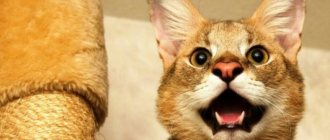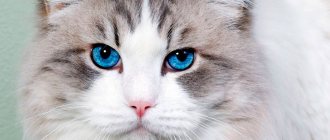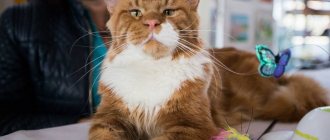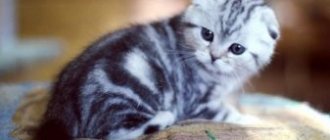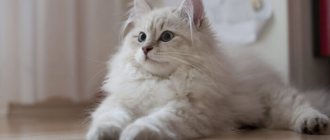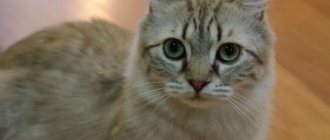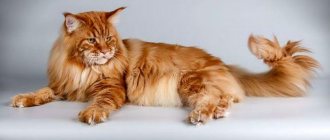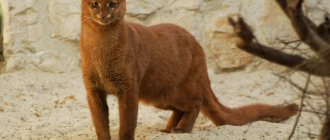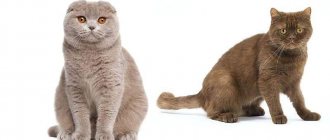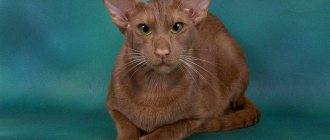Home » Other animals
During the life of cats among people, many breeds have been bred as pets, some of which have gained popularity and are familiar to many, others have remained scarce and unknown. And there are breeds that have been preserved from ancient times in the wild and have not evolved; today there are very few of them left. Today we will get acquainted with very rare breeds.
- 2 Serengeti
- 3 Mekong Bobtail
- 4 Caracal
- 5 Toyger
- 6 Elf
- 7 Serval
- 8 Savannah
- 9 Chausie
“Rarity” of a cat breed - what is it, which breeds are rare
The concept of rarity is related to how difficult it is to obtain (meet) a particular item. The rarity of the cat breed is manifested in the fact that it is difficult (or simply not wanted) to buy due to:
- small number of nurseries,
- breeding difficulties,
- instability of breed characteristics,
- lack of recognition of the breed by the felinological world,
- that it doesn't arouse people's interest,
- etc.
In general, there are many factors due to which a breed can be considered rare.
Breed recognition is a complex process. A purebred cat must have the appropriate documents and be registered with one of the cat (feline) associations.
The rarest cat breeds are experimental, in the process of becoming accepted by cat associations. For example, according to TICA (International Cat Association), such breeds include: Ruffle, Ragamuffin, Bambino and others. On the other hand, established and long-known breeds (Turkish Angora, Bengal, Laperm, etc.) are becoming rare simply because people are losing interest in them.
It is difficult to accurately determine the degree of demand for a particular breed; for this you will need to count all its representatives (registered and unregistered), the number of nurseries, conduct population surveys, etc. However, some organizations, for example CFA (Cat Fanciers Association), conduct such studies and submit their reports annually.
Table: breed popularity rating according to CFA in 2017
| 1 | Exotic | 23 | Selkirk Rex |
| 2 | Ragdoll | 24 | Japanese Bobtail |
| 3 | British Shorthair | 25 | Egyptian Mau |
| 4 | Persian | 26 | RagaMuffin |
| 5 | Maine Coon Cat | 27 | Somalia |
| 6 | American Shorthair | 28 | Balinese/Oriental Longhair (Balinese/Javanese) |
| 7 | Scottish Fold | 29 | Manx |
| 8 | Canadian Sphynx (Sphynx) | 30 | Singapore |
| 9 | Devon Rex | 31 | Bombay |
| 10 | Abyssinian | 32 | Colorpoint Shorthair |
| 11 | Oriental | 33 | Turkish Angora |
| 12 | Siamese | 34 | American Bobtail |
| 13 | Cornish Rex | 35 | European Burmese |
| 14 | Norwegian Forest Cat | 36 | Carthusian cat (Chartreux) |
| 15 | Siberian | 37 | Korat |
| 16 | Burma | 38 | Havana Brown |
| 17 | Russian Blue | 39 | Burmilla |
| 18 | Bengal | 40 | LaPerm |
| 19 | Tonkinese | 41 | Turkish Van |
| 20 | Burmese | 42 | American Wirehair |
| 21 | Ocicat | ||
| 22 | American Curl |
The difficulty in assessing popularity on a global scale also lies in the fact that some breeds are not recognized and registered by some cat organizations, but are recognized and registered by others, that is, some breeds are rare in some regions, while others are rare in others.
Table: recognition of some breeds by international cat organizations
| Breed/association | FIFe | TICA | CFA | GCCF |
| Turkish van | + | + | + | + |
| Elf | — | — | — | — |
| Burmilla | + | + | + | — |
| Khao-mani | — | + | — | — |
| Minuet | — | + | — | — |
| Munchkin | — | + | — | — |
| Ragamuffin | — | — | + | + |
| Laperm | + | + | + | + |
| Serengeti | — | + | — | — |
Let's take a closer look at some rare breeds.
Turkish van
Despite the fact that the Turkish Van is recognized by many felinological organizations, it is rare and occupies the penultimate 41st place in the CFA ranking.
The Turkish Van is a breed of semi-long-haired domestic cat. It was bred in the mid-20th century from animals living in Central and Southeast Asia, including Turkey in the area of the city of Van.
These are large and heavy cats weighing up to 9 kg, which are famous for their unique color - white cats with a bright red tail and the same bright spots on the head. The eyes are usually shades of red, but can also be blue. There are also odd-eyed cats that look very impressive.
The classic coat color is basic white, the tail is colored with red rings, spots of red are also located on the muzzle below the base of the ears
The classic coat color of Turkish Vans is the so-called Van color, when the tail is colored red, as if in rings, and the same color spots on the muzzle below the base of the ears. The rest of the fur is snow-white. There must be at least 4/5 of the color white.
Cats of this breed are positive and active, are in good health, love walks, communicate with people and other animals, and also have an unusual feature - they love water and swimming. In their native region, they even received the name “swimming cats.”
Turkish Van cats are not only not afraid of water, but also swim with pleasure.
The price of a Turkish Van kitten starts from 7 thousand rubles. You can buy it, for example, in the Russian nursery “Tender Bayun” or directly in Turkey.
Caracal
This warlike animal has been domesticated in Africa and Asia for hunting purposes since ancient times. Caracals were used to catch small antelopes, hares, pheasants and peacocks in the same way that dogs were used for hunting purposes in Europe and America. Interestingly, all nine varieties of caracals were domesticated and became indispensable assistants for people who went hunting.
But recently, caracals have also begun to be used as pets, although people are still afraid of their wild roots, and some breeders equip real enclosures for these miniature lynxes for safety reasons. In any case, the devil is not as scary as he is painted, and therefore caracals are quite capable of getting along with a person at home.
The main thing in raising caracals is to remember their unprecedented muscles and energy and in every possible way to promote the outburst of emotions, otherwise it is possible that your pet will get into trouble.
Otherwise, they are consistent, balanced and kind, and if their owner shows due care and respect, then these predators will become true friends and protectors. Due to the development of hunting instincts, you should not combine caracals with other animals, especially small rodents and birds.
Important! To ensure maximum comfort for the caracal breed, you should walk your pupil outside at least once a day, and also take him to the park, where you can let him off the leash so that he can run around to his heart's content. You shouldn’t worry that the cat will run away, because he knows his territory and his owner and will never leave it of his own free will.
The color of Caracal cats mainly predominates in fiery and sandy shades. It can be terracotta, beige, sand, peach or golden red, but one way or another the fur of this predator is quite hard and fluffy. A characteristic feature of the caracal is long black tufts on the ears and a rather short tail.
His emerald eyes always sparkle with the fire of excitement and curiosity, and his muscular legs and body are capable of giving him unprecedented speed and agility, comparable to his wild relatives.
Elf
Elves are completely absent from the CFA rankings, since almost no one (except The Rare and Exotic Feline Registry) recognizes the breed. Breed standards have not yet been established; there are few breeders, breeding animals and kittens.
In Russia, the breeding of elf cats is carried out, in particular, by the Murmulet nursery. I decided to check with the nursery representatives whether the elf breed is registered in any cat association. Representatives of the Murmulet nursery responded that at the moment this breed is considered experimental, for this reason it is not available anywhere.
Nevertheless, elves are a new breed of hairless (hairless) cats that appeared in the United States at the beginning of the 21st century as a result of crossing the American Curl and the Canadian Sphynx. The fairy-tale name of these cats is due to their specific appearance: the cats have unusually folded ears (a legacy of the Curl).
The weight of such a cat is 4–8 kg, the skin color can be any, the almond-shaped eyes are blue or light brown. Elves have a special hanging belly, consisting of numerous folds.
Large ears with tips curled back give the face a fairytale appearance
Since the breed is very young, not all the character traits of this animal have been studied. Owners and breeders note that elf cats have so far proven to be calm, affectionate and intelligent. They communicate well with all members of the household, even with small children. They love to participate in all the affairs of the owner. The lack of fur imposes some restrictions: cats love warmth. The owners also noticed that elves can be vindictive - they do not forget grievances.
You can buy an elf kitten in the USA or in Russia (Murmulet, Magnificent nurseries), the average price for it is from 60 thousand rubles.
Video: Elf - a fabulous breed of cats
Toyger
The very pronunciation of the name of this breed already evokes associations with tigers. And this is by no means a false impression is confirmed by the original color of black and brown stripes covering the entire body of the animal from muzzle to tail. Due to the fact that this breed was bred relatively recently (about 25 years ago), toygers are considered rare cats due to the small size of their population.
The history of the appearance of Toygers begins in the USA, where the famous breeder of the Bengal cat breed decided to continue her scientific research and create another original breed. She sketched out a sketch of the proposed animal and began to select the necessary material.
As a base specimen, she took a cat that she accidentally saw and picked up while traveling in India. He became the progenitor of the modern breed. The name toyger was chosen for a reason, because in English it means “toy tiger.”
The toyger absolutely justifies its title. In 2006, this breed was demonstrated for the first time at an international exhibition and it achieved unprecedented success. After all, who wouldn’t want a miniature tiger to live in his house, and a tame and domesticated one at that? And although toy tigers are smaller in size than real ones, nevertheless, a weight of 8 kg is not the limit for them.
The coat color is characteristic orange-brown with black and dark brown stripes. The tail, like tigers, is ringed with stripes, and the tip is decorated with a large black spot. The coat is short and shiny, silky to the touch.
His character is exactly the opposite of tigers. The toyger looks more like a soft plush toy than a formidable predator. They are soft, flexible and not picky. They are playful and active, and also require increased attention from all people living next to them. Despite its rather large size, such a cat can fit perfectly into a small apartment and will be a wonderful addition to the comfort of your home.
Now you know the name of the breed of cats that look like a tiger, but this similarity, fortunately, is only external. Work is currently underway on the breed. The goal is the following: to breed a snow-white breed with silver stripes. This color will be even more attractive than the classic one. What will come of this? We'll find out in the near future.
Burmilla
Burmilla occupies 39th place in the CFA ranking, and so far its popularity is only gaining momentum. The Burmillas are native to Great Britain. The beginning of the breeding program is considered to be 1981.
The appearance of the breed was helped by chance. As a result of the union of a Persian chinchilla cat and a lilac Burmese cat, beautiful cubs appeared, which gave rise to a new line.
The Burmilla is a medium-sized cat, weighing 4–7 kg, with greenish eyes. The coat can be either short or long. Burmillas are cats with an undercoat that has a base color of white-silver or warm golden with shaded orange variations. However, the tips of the hairs can be painted in different colors. The color of the fur on the belly is lighter than on the back, tail, and also on the muzzle. The eyes of these cats are large and widely spaced. Between them in the forehead area you can see a pattern similar to the letter “m”.
The main color of the Burmilla is white, and the tips of the hairs are colored cream.
The character of the Burmilla is calm and accommodating, but the cat will not refuse games. Owners note that these pets are “talkative.” Even the name of the breed is consonant with the purring. Burmillas are good companions who become very attached to their owners and love to go for walks.
A purebred Burmilla with a good pedigree can be bought in Russia, for example, at the Lambert nursery. The price of a kitten is from 30 thousand rubles.
Serengeti
This is another native of the African continent. Her coat is decorated with attractive spots. With its flexibility and grace, the Serengeti resembles a wild cat and a serval. To get this breed, breeders crossed Abyssinian and Bengal cats.
Representatives of this breed are very calm and easily make contact with people. Little Serengetis are very active and love to play. Thanks to their docile nature, cats get along well not only with humans, but also with other animals, so problems with them never arise.
Khao-mani
The Khaomanee is now recognized only by TICA, so it is not surprising that the breed is considered rare. At the same time, the Khao Mani is a very ancient breed, whose homeland is Thailand. The first mentions of kao-mani are found in literary sources of the 14th century.
“White gem” is the name of a cat of this breed translated from Thai. “White pearl”, “cat with silver and gold eyes”, “white jewel”, “diamond eye” - these are just some of the artistic comparisons that this delightful animal is rightfully awarded.
Kao-mani is in its infancy. The breeders of the breed can be listed on one hand: 4 official breeders are registered on the TICA website (and, for example, there are 24 registered breeders of Siberian cats).
An important point: the authenticity of the breed is confirmed only by a genetic blood test. Therefore, you need to understand that not all white shorthair cats are Khao Mani cats.
In general, representatives of the breed are distinguished by dazzling white short hair, shiny (diamond) eyes with a bright blue edging (heterochromia is also found, when one cat’s eye is blue and the other is yellow or green). The cat is small in size, weighing from 2.5 to 4 kg.
A distinctive feature of the kao-mani is its shiny eyes with a rim.
Kao-mani are prone to deafness, which also reduces the population of healthy animals involved in breeding.
There are few breeders of Khao Mani cats. There are a few in the USA and European countries. In this regard, buying a cat for breeding is very difficult and expensive. Even pet-class animals are an expensive pleasure that few people can afford. The average price of a kitten is 30 thousand rubles. For well-born and exterior individuals, the price can reach 100 thousand rubles.
Video: kao-mani cat
La Perm
These cats are bought by those who like long, curly fur. Of course, anyone who sees this wavy beauty will immediately want to pick her up and stroke her. The breed is considered extremely rare, so seeing one is considered a real success.
The appearance of La Perma was influenced not only by genetics, but also by mutation. The mother of such kittens was a cat with absolutely smooth fur, but her babies were born looking like little sheep.
These cats not only have a unique appearance, but also a kind character. Many people believe that caring for such fur is quite difficult and even painful. But this is not true at all. Nature has made it so that their curls do not get tangled, no matter what factors influence them.
Minuet
Minuet (minuet, also known as Napoleon in the past) was recognized by TICA in 2016. From this moment on, Minuettes were able to take part in exhibitions, but there are still very few breeders of the breed, and accordingly, it is not easy to obtain a kitten with the appropriate documents. Other organizations are still ignoring the breed.
The minuet appeared in the USA in the early 90s. Breeders crossed representatives of the Persian breed with a Munchkin. The experimenters wanted to get a mini-cat with a cute kitten face, a toy-cat. There was no goal to breed a short-legged individual. But to the delight of breeders, unusual short-legged cats were born.
There may be irony hidden in the original name of the breed. Emperor Napoleon was short. In addition, as historical sources testify, a cat scared him as a child, and subsequently, when he saw cats, Napoleon felt extreme discomfort, a kind of neurosis.
The key feature of this breed is its small size: the minuet is almost 2 times smaller than a regular cat, the average weight of representatives is only 2 kg.
This cat's coat can be plush and short, but there can also be long-haired variants reminiscent of Persian cats. The coat color is very varied. These tiny cats are a breeder's dream come true of having the cutest feline pets.
Minuet Napoleon - a tiny cat with a cute kitten face
Napoleons are kind, affectionate, and devoid of any aggression. But these little ones are also the most vulnerable of the felines. Future owners need to remember that the breed is intended exclusively for home keeping. Outside the house, due to their small size and absolute non-hostility, animals can die.
For a minuet kitten you will have to pay from 40 thousand rubles.
 Snowshoe (Snow Shoes)
Snowshoe (Snow Shoes)
This is another very beautiful cat breed, but, unfortunately, one of the rarest. Snowshoe is a hybrid of Siamese origin. The breed dates back to the 1960s, but due to its ever-changing popularity, the number of Snowshoe cats has periodically fallen or increased over the past 50 years. Today, attempts are being made to preserve the breed, and it seems that there is already a positive result, because the Snowshoe is already known all over the world.
Munchkin
Munchkin does not appear in the CFA rankings because the organization does not yet recognize him. And despite the fact that the breed is already actively used to create other breeds (they are crossed with Persian cats, sphinxes, etc.), munchkins are still rare and unclaimed among people.
This munchkin breed can be safely called short-legged cats, dachshund cats.
Munchkins appeared in the USA in the early 80s of the last century, but the first mention of them was made in the first half of the 20th century. In 1983, an American woman from Louisiana picked up a pregnant cat near her ranch that had unusually short legs. Such short legs were probably due to genetic changes. The cat's kittens were also born with short legs, and soon many short-legged cats appeared in the ranch area. And so a new breed arose.
Munchkin is a little man from a fairy tale about the land of Oz.
In September 1994, TICA accepted the breed into its New Breed Development Program. Munchkins received full recognition in 2003.
The Munchkin belongs to the category of breeds resulting from a genetic mutation. Breeding purebred individuals is a very difficult and risky activity, for which you need to be well versed in breeding issues. For example, if you breed a munchkin with a munchkin, then very often the kittens are born dead or die soon.
With an average body length, munchkins' paws are 2–3 times shorter than those of ordinary cats. This physical feature also leads to unusual behavior in cats. The Munchkin's favorite position is resting on its tail. Funny short legs hanging on the sides make the munchkin look like a kangaroo. In this position, the cat does not experience any discomfort and can sit for a long time, touching the owner.
Munchkins are medium-sized cats, weighing up to 6 kg. The coat can be either short or long. Different colors are allowed, as is eye color, which does not depend on color.
With an average body length, munchkins' paws are 2–3 times shorter than those of ordinary cats.
Munchkins are funny, playful cats. According to reviews from owners, they are not particularly talkative, meow little, and are very clean. Cats tolerate travel well and can accompany their owner everywhere.
The price of a munchkin kitten starts from 25 thousand rubles. Nurseries engaged in breeding the breed in Russia:
- "Murmulet";
- Super munchkin;
- Sunny Fairies;
- Puzzle Enjoy.
Video: munchkin - dachshund cat
Ragamuffin
The Ragamuffin breed has not yet taken a strong place in the world and is not recognized by all international associations. The Ragamuffin is classified as an experimental breed by TICA. The breed was registered with the CFA in 2003 and received full recognition in 2011.
Ragamuffin is ranked 26th in the CFA popularity rankings. Considering that the breed is registered only in organizations based in America and England, then 26th place means that there are few Ragamuffin cats in the world. Despite this, Ragamuffins successfully participate in exhibitions and are very popular with cat fans.
The name of the breed ragamuffin cat translates as “ragamuffin cat.” It appeared in the USA in the 60s of the last century. Obtained by crossing ragdolls with yard mongrel cats. The breeders wanted variety; they needed individuals with a wider range of colors and, moreover, a calm disposition. In the 70s of the last century, the experiment was continued, and breeders crossed with Persian and Himalayan cats. The resulting breed was initially called Cherub, but was later renamed.
Ragamuffins are large cats with an average weight of 5–8 kg. The color is varied. The coat is medium length, very soft, quite thick and smooth. The texture may vary depending on the color. The fur around the neck forms a hanging collar, it is also longer on the muzzle, and on the hind legs it forms so-called pants. Eye color is also very diverse.
Ragamuffin fur is longer around the neck, along the contour of the muzzle, and on the hind legs
Ragamuffins are melancholic and affectionate, but at the same time playful and smart. Easily adapt to any living conditions. They love to perch on their owner’s lap, allow themselves to be squeezed, are well trained, and can walk on a leash. They get along well with other pets, as these cats have poorly developed hunting instincts. Ragamuffins are not aggressive and do not know how to defend themselves. Their method of defense is to hide away.
This breed is not bred in Russia. If you want to purchase such a cute animal, you will have to contact foreign breeders and order a kitten from them. The price of a kitten starts from 30 thousand rubles. Like other breeds, the cost depends on the exterior characteristics of the baby or adult animal, as well as gender and pedigree.
Sokoke
The Sokoke's ancestors came from the reserves of Kenya. Therefore, outwardly, she looks like a predator. But despite this, Sokoke has a rather flexible and calm disposition. These pets love to play with children and are always friendly.
The cat has a unique coat color, with complex brown patterns on golden fur. She owes this appearance to her wild ancestors.
Laperm
According to the CFA report, Laperms take 40th place in the ranking, so we can say that there are few such cats in the world and the breed is rare.
The LaPerm breed appeared in the USA in 1982. An ordinary outbred cat gave birth to a completely hairless kitten, which over time acquired funny curly hair, apparently this was the result of a natural mutation.
The name has American roots: “perm” (from English perm) means “perm”, and “la” is an article of the Chinook Indian tribe, which the Indians used without purpose, adding to various words. The founder of the breed, Linda Koehl, called these strange cats this way with irony.
It is difficult to confuse a Laperm cat with a representative of another breed. Their curled fur resembles that of a lamb. This is due to the dominant curly hair gene. In size, these are small cats weighing from 3 to 5 kg. The color of the coat and eyes is the most varied without restrictions. Lapermas come in short-haired and long-haired varieties. Short-haired dogs have a coarser coat, while long-haired dogs have a silkier coat.
A feature of the Laperm breed is its twisted, curly coat, reminiscent of a fur coat.
The main feature of the character of this breed of cats is that Laperms love to communicate with people, they get used to the owner, and not to the house, accompany him everywhere and are excellent comrades and companions. Cats love to talk, but they don’t scream, they purr more. Cats have hunter instincts, but lapermas, as a rule, do not attack other pets.
There are few breeders of the Laperm breed in Russia. You can buy a kitten, for example, at the Russicurl nursery. Prices for kittens vary from 30 thousand rubles and above, depending on breeding quality, gender, color, and purpose of purchase.
Video: laperm - curly cats
Nibelung
This exotic cat breed with an unusual name resembles the Russian Blue cat in appearance. The main difference between this American breed and the Russian Blue is its long, silky coat. The coat color of both breeds is a beautiful shade of blue.
Luxurious fur is both a source of pride for a cat and a headache for its owner. You need to take care of such a fur coat regularly, competently and carefully. The owner will have to comb the fur to prevent tangles from forming. It is also necessary to ensure that the pet is not exposed to direct sunlight. Ultraviolet radiation destroys the coloring pigment of wool, the blue color in the sun becomes ugly with a rusty tint.
Price
In Russia – 55,000 – 80,000 rubles; There are no breed nurseries in Ukraine.
